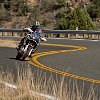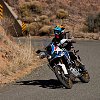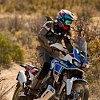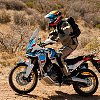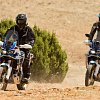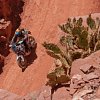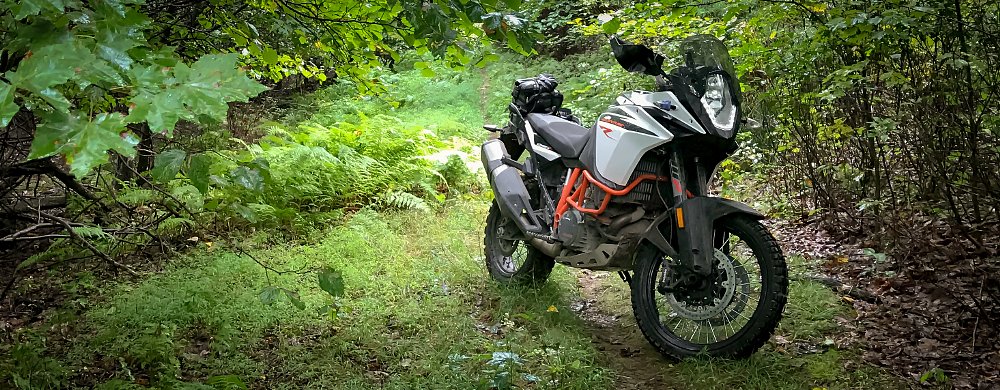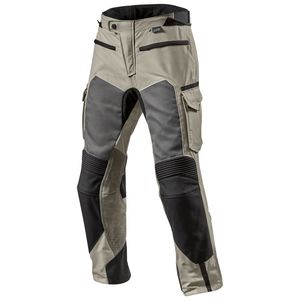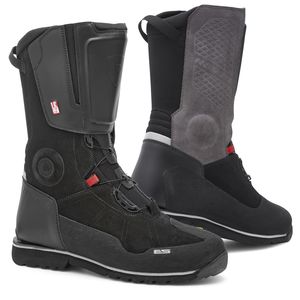When Spurgeon went to an OEM press launch recently, I told him to break a leg. He busted a knee. That's not what I meant. High on pain pills, he calls me about the "new Africa Twin."
Spurgeon: "It just has a bigger tank, right?"
Me: "No." (I list all the changes I've read on the interwebs.)
Spurgeon: "Are you sure?"
Me: I get on a plane and fly to the press launch instead of arguing with Sky Captain Dunbar on the Painkiller Express.
Honda CRF1000L2 Africa Twin Adventure Sports DCT
Yeah, it's a mouthfull (let's just call it the L2 from now on to save space). Yes, the tank is bigger (one point for the Sky Captain). It holds 1.43 gallons more than the standard, to be exact. I've ridden a couple thousand miles on the standard Africa Twin and if you rode 50 miles from a gas station, you thought twice before passing the next one on some of the remote stretches of roads out west. That's why Honda built this bike the way they did. To be a premium, loaded-up, long-distance adventure machine!

Honda will still offer the standard CRF1000L"1" Africa Twin, which also gets some updates, but not all. Both get the "updated" dashboards with rider modes, ride-by-wire throttle (yet no cruise control for either model — face palm moment), a lighter lithium-ion battery (5.1 pounds lighter), wider footpegs with stronger steel mounts, the new larger (no volume given) air box, lighter counterbalancers, and a revised exhaust that's said to boost mid-range. Additional upgrades on the L2 take it to nine out of 10 in terms of being adventure-ready in stock form. (All these updates put me well ahead in the points against Sky Captain Dunbar).
The most notable differences on the L2 are the premium suspension, larger fuel tank, heated grips with five levels of "mmmm heat," rear luggage rack, a larger, more off-road-capable skid plate, 80 mm taller windscreen and crash protection, all of which come standard on the L2.

Most exciting for us adventure riders who really load up a motorcycle for backcountry exploring is going to be the suspension. Travel is increased 0.8 inches both front and back (or 0.9 inches up front, depending on which technical data sheet from Honda you go by) and ground clearance is increased 0.8 inches (if you happen to be weightless but also still touching the earth).
The 1,000 cc parallel twin with a 270-degree firing order remains the motivator for the Africa Twin, with a few tweaks. It has a larger volume intake with 20 mm longer "suck" funnels inside of it to help with the mid-range power. Honda has also ditched 10.6 ounces from the engine's balancer-shaft weights to — and I quote — "add character and feel in power delivery."
Apparently Honda figured out that most of us adventure riders want everything taller. The taller windscreen is now one of the best on the market when it comes to stock windscreens at highway speeds. The taller handlebar risers raise the grips 1.3 inches for all those people who think they need to be higher to stand on an ADV bike (I don't, but don't listen to me). It doesn't change the seat-to-handlebar height difference much, since the new seat on the L2 is 1.2 inches taller to give it a flatter profile. When you factor in the taller suspension, the seat height becomes 36.2 inches in the "tall" position. Did I mention everything's tall now?
Praise the lowered! A new dashboard! Honda has given us a new instrument panel that's been mounted at a more appropriate angle for adventure riders to look at while standing and get a quick glance to see what gear they're in or what speed they're traveling. While everyone else is putting TFT displays on their flagship bikes, Honda has opted for a non-color backlit LCD display. More on that later.

Honda really wanted to show off the new technology on their Africa Twins and that starts with the four rider modes. Three are pre-programmed: gravel, urban, and touring mode. Each mode can be adjusted but will go back to a default setting once the bike is shut off. The fourth is "user" mode and can be programed for three levels of power delivery, three levels of engine braking levels and seven levels of traction control. Traction control can be turned off but resets to level one every time the ignition key is turned off. It should be noted that level one is almost off. Level one allows the front wheel to leave the ground by quite a bit (I think you could flip the bike) and has plenty of leeway for massive power slides (that could easily turn into low-sides). It's more of a "you're way out of line" safety net setting than traction control. ABS can also be shut off at the rear wheel with the push of a button, as long as you're not moving.
When you want to showcase your new tech packages, it's best to remove all other distractions from the equation, like shifting and using the clutch. That's why Honda only brought Dual Clutch Transmission (DCT) models for testing. The internet is littered with articles on how this system operates, but for quick reference it has two clutches. One drives the bike and the other selects the next gear for very fast and direct shifts, up or down. The DCT has four shift modes: drive and sport one, two and three. There's also a "G" drive button for the DCT model that Honda says reduces clutch slip during gear changes.

Riding the Honda CRF1000L2 Africa Twin on the road
What's it like to ride? Here are the (my) riding impressions from a guy who rides adventure bikes a little (a lot) too hard and grades off-road performance by how fast it can carry me through a rally stage or whether it can get through a rock slide on the side of a mountain.
It's 8 a.m. in Prescott, Arizona. We are instructed to "mount up." I end up ninja-kicking the seat trying to get my boot over to the other side of the bike. I readjust my leg trajectory for roundhouse kick number two and I'm parked on the L2's new flat seat. The day starts off and I'm in a pissy mood already. I hate big gas tanks and while the L2 isn't modeled after some of the nine-gallon-plus tanks found on other bikes that are labeled "adventure" or "enduro," I still think it's just a little wide where your knees hit it while sitting. Then I slide back a bit on that flat seat and realize there is plenty of room for the average rider. The tank may be a bit intrusive during some advanced off-road techniques, but if you're that advanced you can adjust your riding style to the bike.
Reason number two I'm struggling with myself on this bike is that Honda thought it would be best to have us test bikes with the stock 90/10 street tires on them so we can focus on the technology and "all road" performance. This bugs me for two reasons. First: How am I going to test off-road performance on Honda's "Adventure Sports" bike when it has street tires on it? Second: Everyone will have to buy off-road-oriented DOT tires like TKC80s after buying their brand new fully loaded adventure bike!
I start to calm down as the roads get twisty and I've already got the "user" mode set up in the full-on aggressive jerk rider settings. For reference, it's this: Power delivery is three outta three, max engine braking, traction control off, "G" button activated, and the transmission is in sport level three mode. It should be noted that manual transmission override is available on the fly with the handlebar paddle shifters in automatic mode or in manual-only mode. I chose to leave the bike in auto and dial up downshifts with a press of the thumb paddle.
Throttle-closed DCT downshifts are my new favorite thing. Come into a corner on the brakes and mash the dowshift button twice and the L2 lets out a terrific "bdbdrummm, bdbdrummm" sound as it gets the downshifts done without upsetting the chassis or turn-in trajectory. The L2 blips the throttle for me and does all the leg and clutch work too. I'm starting to smile. Exiting a second-gear left hander, I'm full throttle and the Africa Twin smashes through the next two gears without me lifting the throttle or touching the paddles. Suddenly, I'm howling in my helmet. "Whooooohoooo!"

On-road handling was a little unsettling on the standard Africa Twin at higher speeds with aggressive riding. The L2 comes with massively upgraded compression and rebound damping. While I praised the original Africa Twin for being user-friendly and forgiving, when its loaded with gear and you start to push the limit, it becomes clear that it's undersprung and underdamped. The L2, on the other hand, is well balanced front to rear when carving corners on road and retains its user friendliness, unlike some premium ADV bikes that are unforgiving for the sake of sheer performance.
With a full 1,000 cc of displacement available, this bike should be no slouch, but unfortunately the L2 just lacks get up and go compared to the other middleweight ADV bikes out there. Despite the engine updates to improve the mid-range, it just doesn't move forward like a liter bike should, especially at elevations over 5,000 feet. I suspect that the low compression ratio (10.0:1), car-like low rev limiter, and emphasis on usability are contributing factors.
Harsh words I know, but frantic forward motion is not the most important thing in the ADV world. In fact, it's not even close. The original Honda Africa Twin impressed me when I did some rolling-start drag races against faster 1,200 cc bikes in the gravel during a magazine test and there was no clear winner up to 105 mph. The only thing that we can attribute that to is the way the Honda puts down its power very efficiently. It has hooked up and gotten me out of places (like up to the headlight in the East River in Crested Butte, Colorado) that no other powerhouse bike with a chip on its shoulder would have helped me get out of. Torque is king and mellow engine character helps reduce rider fatigue and rider anxiety when off-road riding gets "gnar gnar."
Gone is the un-readable dash of the 2016-17 Africa Twins. Long live the new, semi-un-readable dash of the 2018s. It's still unreadable at speed while bouncing around and standing off-road. The tachometer might as well not exist and I cannot imagine that someone would think this is OK on a production flagship motorcycle. It's a reverse backlit LCD screen. Imagine a calculator circa 1998, but all the numbers are white and the rest of the screen is black. Not exactly high tech and while it's pointed in the right direction to be viewable while standing, the end user will have a hell of a time reading it unless they're seated and riding on a smooth surface. No tachometer, no problem, on the auto model though, right?

One redeeming factor of the dashboard is that it's easy to navigate and adjust all the rider modes. There are no buried menu settings to unlock and find like on some of the TFT displays. Within five minutes of getting myself familiar with the layout, I had the user mode dialed in without outside help from the friendly Honda "handlers" prompting us over our shoulders. Another bonus of this display is that it's actually easier to read in direct sunlight than any other digital display I've ever seen (it's that good in the sun).
To change the sport mode setting of the transmission, the bike has to be running but stationary and in drive (upon startup it's in neutral every time). You then select sport mode on the handlebar selector and then hold it down till it switches to the sport mode setting you desire and it will stay there even when you shut the bike off. You can activate the "G" button whether the engine is running or not but you must be stationary. You can switch from normal Drive mode to Sport or Manual mode while moving. I know this sounds like a lot, but once you spend a day with the DCT it all becomes second nature.

Finally getting off-road on the Honda CRF1000L2 Africa Twin Adventure Sports
Just because we had street tires on our bikes doesn't mean we didn't take them off-road. We just had to be a little smarter about it. Honda planned our routes for us and it started out mellow. Some dusty gravel roads through the desert terrain. With one-minute gaps between us, we were told to keep our spacing and have a good time (if that isn't a contradiction). Sliding around bends, late-braking turns and third-gear wheelies over crests are my idea of a good time and I quickly began catching others in the group whose idea of a good time was not wadding up a press bike in the desert.
We were doing trail rules for directions. Basically you'd stop at every turn and when the rider behind saw where they were supposed to turn you would take off and they would wait for the next rider. I waved the three riders I passed to go ahead and caught my breath. That's when I saw Jess from Ultimate Motorcycling execute a 100-yard-long rear-wheel skid crossed up into the berm, which he then used to make the right hander and blast on ahead. We spent the next 20 minutes riding together at a pace that cannot be disclosed.
I can confirm that the L2's suspension is major upgrade over the standard Africa Twin off-road, as well as well as on. It still slides without being a knife edge and has the predictable loss of traction that I loved on the standard ATs, but the L2 will be able to keep its composure when the speeds get high, the sand gets deeper and the terrain gets rougher. This is directly due to the increased low-speed damping in the suspension and higher quality components on the L2. (The large suspension movements through the stroke in or out are controlled by the low-speed valving).

We got very little time on rougher trails with larger rocks, but for my own mental well being and to get you the facts I would hope you're interested in, I chose the hardest line through any bit of terrain available and even went off the trail a few times. What I can report back is that the L2 will bottom out much less in rocky terrain, thanks to its stiffer suspension, longer travel, and more abundant ground clearance. The DCT is un-stall-able and going slow over gnarly obstacles is a breeze. You can focus on riding the bike rather than working the clutch or worrying what gear you're in. If it's easier to ride you'll have more fun and if you have more fun you'll ride more.
One thing that might stop the fun for some riders is this bike's seat height. I hate it when people complain about seat heights because it discourages manufacturers from developing ADV bikes with more ground clearance and better suspension. I know, easy for me to say. I'm six feet, two inches tall.
Honda will have low-seat options available that will get you back down towards the standard Africa Twin's 33.5-inch low-position seat height. The standard has always felt lower than it actually is because the tank doesn't interfere with riding positions and the center of gravity is low. That carries over to the L2, as well.

Summing up the Africa Twin and the competition
Sometimes manufacturers miss the (my) mark when they build an "adventure bike" and I usually get super frustrated, but some of the things I look for are not what everyone else wants in an ADV bike.

What about the competition? The KTM 1090R makes nearly 30 horsepower more than the Africa Twin, but I don't personally own one because they're super fast and they also have the same frame as the 1290R and that puts them in the "too big for my taste" category. (That's not a popular opinion; just ask Sky Cap Dunbar, who bought one and thinks it's the shit.) The Triumph Tiger 800 XCA is right there at just under $16,000 and while I love my personal Tiger, it has to be the right bike for the job. The Triumph from the factory is slightly more street-biased. Ducati has the Multistrada 950, at the very street-biased end of the spectrum.
What I'm trying to say is there are really no bad adventure bikes out there. You just need to choose the right one for the jobs you're going to ask it to do. The CRF1000L2 is easily the most well rounded showroom stock adventure bike I've ever ridden.
So is the L2 worth the extra $1,500? Personally, I wouldn't even consider a standard AT after riding the L2. You could easily spend $1,500 trying to upgrade the standard's suspension alone and you still won't have the extra suspension travel and ground clearance. When you consider that you also get the windscreen, bar risers, skid plate, heated grips, luggage rack, and the gorgeous 30th anniversary paint scheme, it's an easy choice.
2018 Honda CRF1000l2 Africa Twin Adventure Sports Specs
| Price | $14,999 |
| Displacement | 998 cc |
| Bore x Stroke | 92 mm x 75 mm |
| Compression Ratio | 10:1 |
| Cooling | Liquid |
| Front Suspension | 45 mm inverted telescopic fork (9.9 in travel) |
| Rear Suspension | Pro-Link system w/ single shock (9.4 in travel) |
| Front Tire | 90/90-21 |
| Rear Tire | 150/70 R-18 |
| Fuel Capacity | 6.4 gal (1 gal reserve) |
| Ground Clearance | 10.7 in |
| Seat Height | 35.4 in |
*as claimed by the manufacturer





